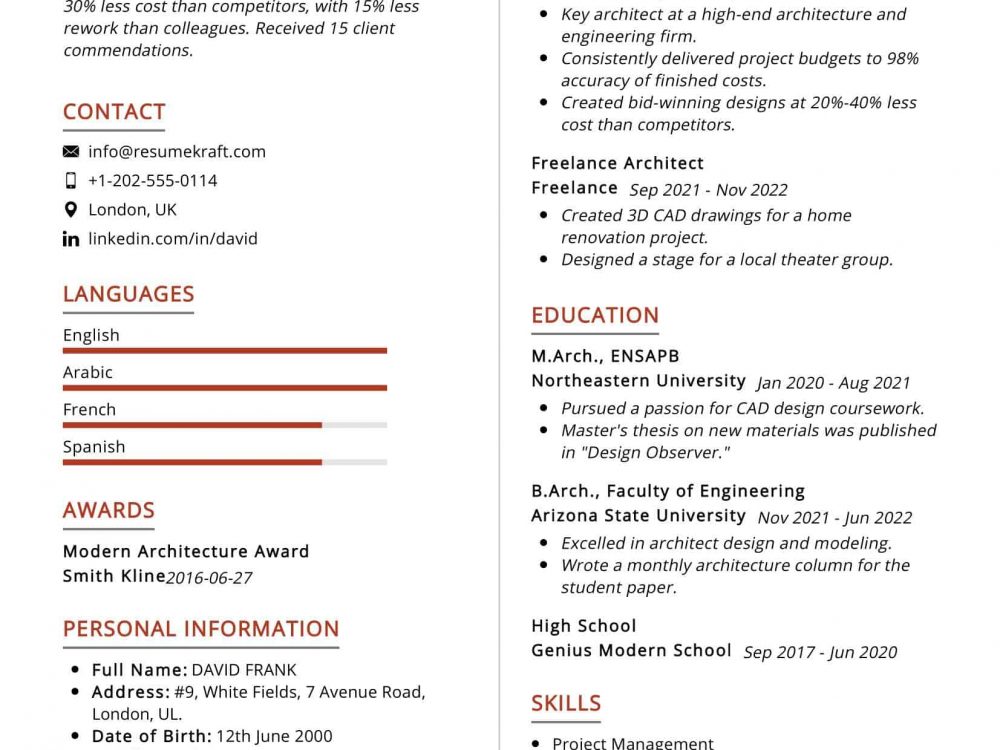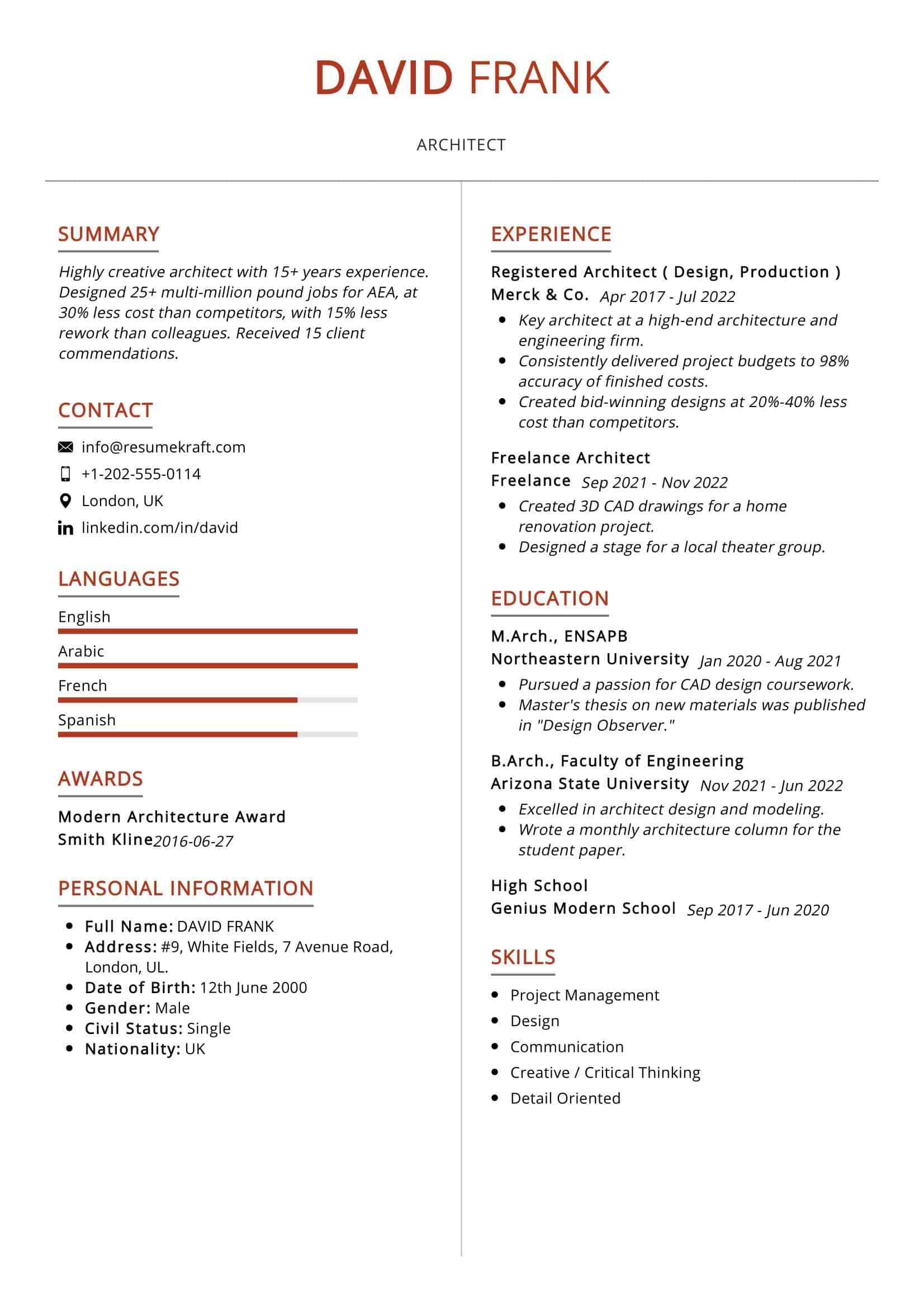Are you an Architect by profession and looking for an exciting career? We have good news for you! use our professional Architect Resume Sample. You don’t have to start writing from scratch. Just click “Edit Resume” and modify it with your details. Update the template fonts and colors have the best chance of landing your dream job. Find more resume samples.
Architect Resume Sample
DAVID FRANK
Architect
Summary
Highly creative architect with 15+ years of experience. Designed 25+ multi-million pound jobs for AEA, at 30% less cost than competitors, with 15% less rework than colleagues. Received 15 client commendations.
Skills
Work Experience
Registered Architect ( Design, Production )
Merck & Co.
- Key architect at a high-end architecture and engineering firm.
- Consistently delivered project budgets to 98% accuracy of finished costs.
- Created bid-winning designs at 20%-40% less cost than competitors.
Freelance Architect
Freelance
- Created 3D CAD drawings for a home renovation project.
- Designed a stage for a local theater group.
Education
M.Arch., ENSAPB
Northeastern University
- Pursued a passion for CAD design coursework.
- Master’s thesis on new materials was published in “Design Observer.”
B.Arch., Faculty of Engineering
Arizona State University
- Excelled in architect design and modeling.
- Wrote a monthly architecture column for the student paper.
High School
Genius Modern School
Languages
- French
- English
- German
- Chines
Career Expert Tips:
- Always make sure you choose the perfect resume format to suit your professional experience.
- Ensure that you know how to write a resume in a way that highlights your competencies.
- Check the expert curated popular good CV and resume examples
Architect Resume with Writing Guide
Do you want to get your dream job? Want to be at the top of your field? Do you need help getting there? If so, work on your resume!
Jobs today are harder and harder to come by. Even in this market, where everyone is having difficulty finding a job, resumes still rule. Employers will look over dozens of resumes from various applicants before they find one that fits their needs well. The steps outlined in this guide are designed to help you make the best impression possible with potential employers. Let’s go!
You’ll want to keep your resume as general as possible, while still highlighting any qualifications that relate specifically to the type of work you’re applying for. The reason for this is so that it can be tailored accordingly when sent in response to a specific job opening.
When writing your resume, it’s highly recommended that you take the time to put a little time into crafting the perfect cover letter as well.
Even though your resume is not likely going to be the source of the first contact with a potential employer (that’s what job ads are for), it’s still important that you highlight all of your relevant qualifications and achievements in such a way that the reader cannot help but be impressed by them.
Architect Resume Writing Guide:
- Introduction
The first thing to do with almost any kind of resume is to have one that is professionally formatted. The line between a well-written resume and a messy or confusing one is usually a very thin line, and it can be easily crossed if care isn’t taken in preparing the document. That can largely be avoided by following this simple guide while also making sure it’s clean, clear, and error-free. More than anything else, your resume has to say what you want the person reading it to know about your skills. - Contact Information
Typically, you’ll want to put the contact information up top, though some resumes can benefit from putting this down below. The important thing is to make it easy for people who might want to get in touch with you for more information or a job opportunity to do so quickly. If possible, include the address for your LinkedIn profile or website at which they can find more information about your experiences and skills as an architect. - Summary
Next, most resumes include a short summary of your skills and experiences, usually in one to two sentences. This is the most important part of your resume, and it’s also where you’ll want to make sure you get your points across clearly and concisely. Follow the rules below for how to write a good summary:
· Be clear and concise. Write as little as possible to get your point across, but be sure to mention all of the experience that is relevant to architecture.
· Keep it relevant. If you know that you have experience in something, but that wasn’t a significant part of your education or career, leave it off. It won’t hurt you to say that you did something in the past, but it won’t help your chances to either.
· Be honest. Honesty is key for this section, and for the whole document.
- Education and Work History
The next major section of almost any resume is the education and work history. The order of these two sections is usually up to personal preference, but seeing as how your education should be relevant to your work history, it’s common to put it first. That’s the case for all of the samples we’ll look at below, so that’s where we’ll begin. Here are some tips for writing an architect resume:
· List school in reverse order, with most recent first.
· Expand on your experiences at the school, particularly the ones that were hard and demanding, but not so much for those that were easy.
· Optionally include your GPA or high school transcripts, but don’t go overboard in saying how you did well in class or what it was you studied as an architecture major. That isn’t relevant to what they should be looking for.
· Wherever possible, list accomplishments instead of simply your job title or company name.
List of Typical Responsibilities For an Architect Resume:
- Experience:
Describe your experience. You can list any construction or design projects that you worked on and the dates they were completed. If you have less than 3 years of experience, you can mention how many years of architectural experience you have and how long your architecture career has been. - Skills:
List the specialized skills required for the job. This should include any technical skills that are specific to the position and not general knowledge about construction. - Education:
List your education and give a brief description of each school you attended. Include the year you graduated and any degrees you received. If appropriate, include information about additional education you have received as part of your training as an architect. - Additional Skills:
List the computer programs that are required for the position (AutoCAD, Revit, etc.) or other specific skills (business management).
Top 10 Must-have Architect Skills:
- Excellent communication skills.
- Strong eye for detail.
- Strong organizational and planning skills, including the ability to manage projects efficiently and cost-effectively.
- Committed to working on both the design and construction stages of a project.
- A proven track record of delivering projects on time, within budget, and to on-spec or higher standards of quality and safety according to local codes and ordinances.
- Initially might consider architecture as a career if you:
- Have a background in mathematics, science and technology.
- Are itching to bring your creative vision to life.
- Enjoy a hands-on challenge and learning new skills and knowledge along the way.
- Wish to work both independently and collaboratively on a variety of projects with teams of people whose talents complement your own special skills, including owners, contractors, subcontractors, consultants and fellow architects.
Tips to write an Architect Resume Summary:
- The Architect Resume Summary is the brief version of your resume. It is ideal for someone working in the design industry.
- If you are a non-designer, it is ok to include some architecture categories on your Architect Resume Summary because these will help employers better understand that you are still in the field of architecture.
- Your job duties can be included in the summary section but not if the same information is also found on the full-length version of your resume.
- You do not need to include a separate summary even if you have a Bachelor’s degree because you may already have all the same information listed in your field or specialty. If you are looking for a job, be sure only to include your education and relevant experience.
- Keep in mind that many organizations will ask for a resume title when they upload it with their online job search site. Your title is an essential part of the design process as it guides people when they look at it and helps categorize and organize the information on your resume.
How to write an Architect Resume with No experience:
- Start by writing down your skills. Make a list of all the things that you are good at. You want to highlight those skills you feel are most relevant to the job for which you are applying. You want this list to feel complete, but you do not need to include everything, or every skill that you have ever learned. List your most recent jobs and any degrees earned in reverse chronological order, with the time period of your employment in brackets.
- Write a description of your work experience.
- Write about the accomplishments that you achieved at those jobs, and quantify your achievements where possible, as in “Increased sales revenue by 50% in one year.”
- Next, write a short statement to introduce yourself. The general purpose of this statement is to introduce yourself, tell the company that you are interested in the company and in its work, and provide a preview of your qualifications for the position. The statement should be part of your letterhead: it should include your name and contact information (address, phone number, e-mail address) and a closing (typically “Sincerely” or “Very truly yours”).
- Next, write an objective statement.
How to write an Architect Cover Letter:
- Use the name of your company.
- Describe what you’re applying for:
- Discuss your relevant qualifications and skills:
- Give an example of a project you worked on, and describe the experience or knowledge you gained from it:
- Mention any positions or clients where you’ve been employed before, and briefly discuss them:
- Ask for a recommendation from a professional or your contact’s supervisor, if applicable:
- Sign off and give your contact details such as name, number, and address:
- Finish with a closing sentence that thanks the reader for his/her time:
- Include the following details at the top of your letter.
- Proofread your letter (more than once!) and make sure all grammar is correct and that there are no spelling errors:
- Remember to add an attachment with your CV:
Key Takeaways:
- The average length of time that it takes to fill an architectural position is 6 months.
- The first step to writing a good resume for the Architect profession is to make sure that you are tailoring it to the position or company that you are applying for.
- Certain sections of your resume should be highlighted such as your education and any certificates or awards that you have received, because they speak directly to the skills needed in order to perform within this career field.


